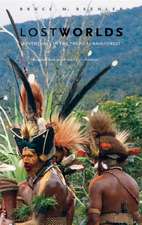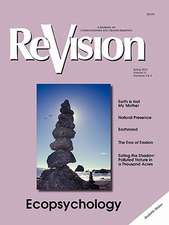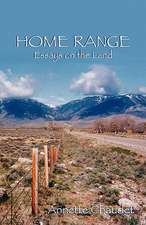Applied Panarchy: Applications and Diffusion across Disciplines
Editat de Lance H. Gunderson, Craig Reece Allen, Dr. Ahjond Garmestani PhDen Limba Engleză Paperback – 20 apr 2022
After a decades-long economic slump, the city of Flint, Michigan, struggled to address chronic issues of toxic water supply, malnutrition, and food security gaps among its residents. A community-engaged research project proposed a resilience assessment that would use panarchy theory to move the city toward a more sustainable food system. Flint is one of many examples that demonstrates how panarchy theory is being applied to understand and influence change in complex human-natural systems. Applied Panarchy, the much-anticipated successor to Lance Gunderson and C.S. Holling’s seminal 2002 volume Panarchy, documents the extraordinary advances in interdisciplinary panarchy scholarship and applications over the past two decades. Panarchy theory has been applied to a broad range of fields, from economics to law to urban planning, changing the practice of environmental stewardship for the better in measurable, tangible ways.
Panarchy describes the way systems—whether forests, electrical grids, agriculture, coastal surges, public health, or human economies and governance—are part of even larger systems that interact in unpredictable ways. Although humans desire resiliency and stability in our lives to help us understand the world and survive, nothing in nature is permanently stable. How can society anticipate and adjust to the changes we see around us? Where Panarchy proposed a framework to understand how these transformational cycles work and how we might influence them, Applied Panarchy takes the scholarship to the next level, demonstrating how these concepts have been modified and refined. The book shows how panarchy theory intersects with other disciplines, and how it directly influences natural resources management and environmental stewardship.
Intended as a text for graduate courses in environmental sciences and related fields, Applied Panarchy picks up where Panarchy left off, inspiring new generations of scholars, researchers, and professionals to put its ideas to work in practical ways.
Panarchy describes the way systems—whether forests, electrical grids, agriculture, coastal surges, public health, or human economies and governance—are part of even larger systems that interact in unpredictable ways. Although humans desire resiliency and stability in our lives to help us understand the world and survive, nothing in nature is permanently stable. How can society anticipate and adjust to the changes we see around us? Where Panarchy proposed a framework to understand how these transformational cycles work and how we might influence them, Applied Panarchy takes the scholarship to the next level, demonstrating how these concepts have been modified and refined. The book shows how panarchy theory intersects with other disciplines, and how it directly influences natural resources management and environmental stewardship.
Intended as a text for graduate courses in environmental sciences and related fields, Applied Panarchy picks up where Panarchy left off, inspiring new generations of scholars, researchers, and professionals to put its ideas to work in practical ways.
Preț: 314.96 lei
Nou
Puncte Express: 472
Preț estimativ în valută:
60.27€ • 63.14$ • 49.95£
60.27€ • 63.14$ • 49.95£
Carte disponibilă
Livrare economică 19 martie-02 aprilie
Livrare express 04-08 martie pentru 34.56 lei
Preluare comenzi: 021 569.72.76
Specificații
ISBN-13: 9781642830897
ISBN-10: 1642830895
Pagini: 344
Ilustrații: 34 illustrations
Dimensiuni: 152 x 229 x 23 mm
Greutate: 0.44 kg
Editura: Island Press
Colecția Island Press
ISBN-10: 1642830895
Pagini: 344
Ilustrații: 34 illustrations
Dimensiuni: 152 x 229 x 23 mm
Greutate: 0.44 kg
Editura: Island Press
Colecția Island Press
Notă biografică
Lance Gunderson is professor and chair in the Department of Environmental Sciences at Emory University in Atlanta, Georgia. His research focuses on the human and institutional dimensions of resource ecology. He is coeditor-in-chief of the journal Ecology and Society.
Craig R. Allen is a professor at the University of Nebraska-Lincoln, and serves on the board of directors for the Resilience Alliance. His research focuses on the links between land use and land cover change, biological invasions, extinctions, and resilience.
Ahjond Garmestani is a research scientist with the US Environmental Protection Agency's Office of Research and Development in Gulf Breeze, Florida, and the Utrecht Centre for Water, Oceans and Sustainability Law at the Utrecht University School of Law in Utrecht, the Netherlands. His research is transdisciplinary and focuses on governance of social-ecological systems.
Craig R. Allen is a professor at the University of Nebraska-Lincoln, and serves on the board of directors for the Resilience Alliance. His research focuses on the links between land use and land cover change, biological invasions, extinctions, and resilience.
Ahjond Garmestani is a research scientist with the US Environmental Protection Agency's Office of Research and Development in Gulf Breeze, Florida, and the Utrecht Centre for Water, Oceans and Sustainability Law at the Utrecht University School of Law in Utrecht, the Netherlands. His research is transdisciplinary and focuses on governance of social-ecological systems.
Cuprins
Preface
Acknowledgments
Part I. Panarchy Concepts
Chapter 1. Panarchy: Nature’s Rules
Lance H. Gunderson, Ahjond Garmestani, and Craig R. Allen
Part II. Applications of Panarchy Theory
Chapter 2. Panarchy, Cross-Scale Resilience, and Discontinuous Structures and Processes
Shana M. Sundstrom, Craig R. Allen, and David G. Angeler
Chapter 3. The Adaptive Cycle: More Than a Metaphor
Shana M. Sundstrom and Craig R. Allen
Chapter 4. Scales of Coercion: Resilience, Regimes, and Panarchy
David G. Angeler and Craig R. Allen
Chapter 5. Applications of Spatial Regimes.
Craig R. Allen, David G. Angeler, Ahjond Garmestani, Caleb Roberts, Shana M. Sundstrom, Dirac Twidwell, and Dan R. Uden
Chapter 6. An Engineering Perspective on Managing for Resilience and Panarchy
Ian Pumo, Margaret Kurth, Stephanie Galaitsi, and Igor Linkov
Chapter 7. Mapping Panarchy to Improve Visualization of Complex Environmental Change
Dirac Twidwell, Daniel R. Uden, Caleb P. Roberts, Brady W. Allred, Matthew O. Jones, David E. Naugle and Craig R. Allen
Part III. Diffusion of Panarchy Concepts
Chapter 8. Capacities for Navigating Large-Scale Sustainability Transformations: Exploring the Revolt and Remembrance Mechanisms for Shaping Collapse and Renewal in Social-Ecological Systems
Per Olsson, Carl Folke, and Michele-Lee Moore
Chapter 9. Panarchy and Law in the Anthropocene
Robin Kundis Craig, Barbara Cosens, Ahjond Garmestani, and J.B. Ruhl
Chapter 10. Panarchy and the Economy
Josh Farley and Megan Egler
Chapter 11. Assessing Panarchy in Food Systems: Cross-Scale Interactions in Flint, Michigan
Jennifer Hodbod and Chelsea Wentworth
Chapter 12. Panarchy and the Governance of Social-Ecological Systems
Brian C. Chaffin
Chapter 13. Cross-Scale Social-Ecological Stewardship for Navigating toward More Sustainable and Just Futures
F. Stuart Chapin III, Reinette Biggs, Nadia Sitas, Carl Folke, and Gary P. Kofinas
Part IV. Summary, Synthesis, and Future Advances
Chapter 14. Applications and Diffusion of Panarchy Theory
Lance H. Gunderson, Craig R. Allen, and Ahjond Garmestani
About the Editors
Contributors
Index
Acknowledgments
Part I. Panarchy Concepts
Chapter 1. Panarchy: Nature’s Rules
Lance H. Gunderson, Ahjond Garmestani, and Craig R. Allen
Part II. Applications of Panarchy Theory
Chapter 2. Panarchy, Cross-Scale Resilience, and Discontinuous Structures and Processes
Shana M. Sundstrom, Craig R. Allen, and David G. Angeler
Chapter 3. The Adaptive Cycle: More Than a Metaphor
Shana M. Sundstrom and Craig R. Allen
Chapter 4. Scales of Coercion: Resilience, Regimes, and Panarchy
David G. Angeler and Craig R. Allen
Chapter 5. Applications of Spatial Regimes.
Craig R. Allen, David G. Angeler, Ahjond Garmestani, Caleb Roberts, Shana M. Sundstrom, Dirac Twidwell, and Dan R. Uden
Chapter 6. An Engineering Perspective on Managing for Resilience and Panarchy
Ian Pumo, Margaret Kurth, Stephanie Galaitsi, and Igor Linkov
Chapter 7. Mapping Panarchy to Improve Visualization of Complex Environmental Change
Dirac Twidwell, Daniel R. Uden, Caleb P. Roberts, Brady W. Allred, Matthew O. Jones, David E. Naugle and Craig R. Allen
Part III. Diffusion of Panarchy Concepts
Chapter 8. Capacities for Navigating Large-Scale Sustainability Transformations: Exploring the Revolt and Remembrance Mechanisms for Shaping Collapse and Renewal in Social-Ecological Systems
Per Olsson, Carl Folke, and Michele-Lee Moore
Chapter 9. Panarchy and Law in the Anthropocene
Robin Kundis Craig, Barbara Cosens, Ahjond Garmestani, and J.B. Ruhl
Chapter 10. Panarchy and the Economy
Josh Farley and Megan Egler
Chapter 11. Assessing Panarchy in Food Systems: Cross-Scale Interactions in Flint, Michigan
Jennifer Hodbod and Chelsea Wentworth
Chapter 12. Panarchy and the Governance of Social-Ecological Systems
Brian C. Chaffin
Chapter 13. Cross-Scale Social-Ecological Stewardship for Navigating toward More Sustainable and Just Futures
F. Stuart Chapin III, Reinette Biggs, Nadia Sitas, Carl Folke, and Gary P. Kofinas
Part IV. Summary, Synthesis, and Future Advances
Chapter 14. Applications and Diffusion of Panarchy Theory
Lance H. Gunderson, Craig R. Allen, and Ahjond Garmestani
About the Editors
Contributors
Index
Recenzii
“The nexus of thought and application that breaks down the disciplinary boundaries is clear to see in the examples provided in this book. I have no doubt that the broad academic movements investigating resilience in the Anthropocene will gain much from Applied Panarchy.”
Descriere
Although humans desire stability in our lives to help us understand the world and survive, nothing in nature is permanently stable. How can society anticipate and adjust to the changes we see around us? Scientists use panarchy theory to understand how systems—whether forests, electrical grids, agriculture, coastal surges, public health, or human economies and governance—interact together in unpredictable ways. Applied Panarchy, the much-anticipated successor to Lance Gunderson and C.S. Holling’s seminal 2002 volume Panarchy, documents the extraordinary advances in interdisciplinary panarchy scholarship and applications over the past two decades.
Intended as a text for graduate courses in environmental sciences and related fields, Applied Panarchy picks up where Panarchy left off, inspiring new generations of scholars, researchers, and professionals to put its ideas to work in practical ways.
Intended as a text for graduate courses in environmental sciences and related fields, Applied Panarchy picks up where Panarchy left off, inspiring new generations of scholars, researchers, and professionals to put its ideas to work in practical ways.














